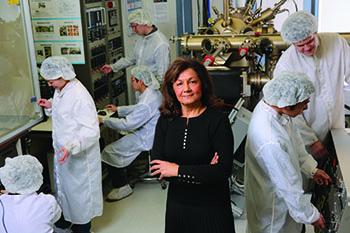
OSA Fellow Manijeh Razeghi in her Northwest University lab. Credit: Andrew Campbell, Northwestern University
Chemical sensors with lasers operating in the mid-infrared region between 6 and 10 µm—the so-called fingerprint region—are used in many different applications, from breathalyzers to homeland security to pollution control. A team of researchers from Northwestern University (USA) reports that it has overcome the size and power issues that plague traditional chemical sensors with a new small, ultra-broadband quantum cascade laser design that could be integrated into a portable device (Opt. Express, doi: 10.1364/OE.23.021159).
Chemical sensors typically employ mid-infrared lasers because they can detect chemicals, even in trace concentrations, through the molecules’ strong resonant absorption of mid-infrared radiation. However, optically pumped mid-infrared lasers are too complex for field use, and the smaller diode mid-infrared laser sources have limited spectral range.
OSA Fellow Manijeh Razeghi and her colleagues at Northwestern’s Center for Quantum Devices used quantum mechanical design, optical engineering and materials development to integrate multiple wavelength emitters into a single compact laser diode. Their heterogeneous quantum cascade laser consists of stacks of discrete wavelength quantum cascade stages that emit light between 5.9 and 10.9 µm—within the spectroscopic fingerprint region—with a peak output power of over 50 mW. A distributed-feedback array in the design emits at fixed frequencies, covering an emission range of about 760 cm-1, which is about 59 percent relative to center frequency. These results are an improvement on the team’s last quantum cascade laser that demonstrated a tunable range of 236 cm-1 at a wavelength of 4.65 µm.
When tested, the device, which is smaller than a penny, was able to emit broadband wavelengths on demand at frequencies within 30 percent of the laser central frequency at room temperature. That’s a feat, the researchers claim, that has never before been demonstrated with a single-laser diode.

